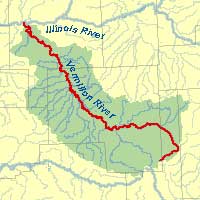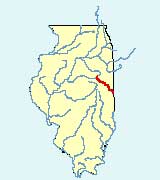Choose another river
Vermilion River


©Illinois State Water Survey
Vermilion River - Illinois Basin
The Vermilion River in east-central Illinois is a tributary of the Illinois River. It is 112 miles in length and has a drainage area of approximately 1,330 square miles. Its major tributaries include Long Point Creek and Rooks Creek. The Vermilion River begins as North Fork Vermilion River, which flows northwest for 37 miles and becomes the Vermilion River in central Livingston County. The Vermilion then continues northwest and drains to the Illinois River near Oglesby. This river should not be confused with the Vermilion River in eastern Illinois, which drains to the Wabash River.
River Information: The Vermillion River is a fisherman's paradise, with numerous eddies, slack pools, overhanging and downed trees, deep holes and rocky shorelines.
The Vermilion is a great place to go Fly Fishing. The most interesting section for fly fishers is the eight-to-eleven-river-mile stretch from the Illinois Route 178 bridge that crosses the river just above Mathiesson State Park, down to the take-out access-point bridge at the Ed Hand Highway, a 1/4-mile south of Route 71.
For a full experience, drop a pole while drifting the river in a raft or canoe. Rafts are available at the Vermilion River Rafting Company located at the Route 178 bridge. You can cast while drifting or stop to wade-and-cast the most promising-looking water.
For those who prefer wading, access by foot, while limited, is available. You can park at the Dells Area section of the Mathiesson State Park and walk half-mile walk to the river. Or if you park at the Vermilion River Area of the Park, it's a half-mile walk downhill through scenic, forested-trails and across bridges. You can then wade upstream and/or down to enjoy some wonderful fishing.
River Access: The Vermilion River is limited in the number of public access points it has to offer. There are public boat ramps located in Streator and Pontiac. The lower part of the river is also a popular destination for canoeing and kayaking. There are also a few additional bridge crossings and roadside areas that are popular with local residents.


©Illinois State Water Survey
Vermilion River - Wabash Basin
The Vermilion River in eastern Illinois is a tributary of the Wabash River. Within Illinois, the Vermilion River has a length of 95 miles and a drainage area of approximately 1,300 square miles. Its major tributaries include Salt Fork Vermilion River and North Fork Vermilion River. The Vermilion River originates in Ford County as Big Four Ditch, which becomes the Middle Fork Vermilion River. Beginning at the confluence of the Middle Fork and the Salt Fork, the river is referred to as the Vermilion. With the additional drainage of the North Fork near Danville, the Vermilion flows southeast until it enters the Wabash River in Indiana. This river should not be confused with the Vermilion River in east-central Illinois, which drains to the Illinois River.
Middle Fork State and Wildlife Area: The Middle Fork State Fish & Wildlife Area is located 6 miles north of the Interstate 74 exit at Oakwood in Vermilion County. It got its name from the Middle Fork branch of the Vermilion River, which flows between Kennekuk Cove County Park and Middle Fork State Fish & Wildlife Area. The Middle Fork River passes out of the Middle Fork Wildlife Area into Kickapoo State Recreation Area about 10 miles downstream. At Kickapoo you can enjoy family camping, picnicking, fishing, boating, mountain biking and rent a horse for a short trail ride.
The Middle Fork River offers the angler opportunities for such species as smallmouth bass, bluegill, sunfish, crappie, channel catfish, walleye and bullhead. Access to the river is by footpaths at Kinney's Ford, Higginsville Bridge and Bunker Hill. See here for more information about the Middle Fork State Fish and Wildlife Area.
Species |
Rank |
Fish Status |
Good | The Vermilion River sites most abundant per hour of electrofishing for bluegill were at the Houder Cemetery site in Livingston County. The largest one collected was 7 inches, collected at the site near Sandy Ford Nature Preserve in LaSalle County. | |
Good | Electrofishing surveys produced the highest catch rates near Sandy Ford Nature Preserve between Oglesby and Streator in LaSalle County. The largest channel catfish of the 2009 surveys was 22 inches, collected from that same site. | |
Fair | Flathead Catfish were only collected at two of the Vermilion River sites, Sandy Ford Nature Preserve and Streator. The largest was from the Streator site at 21.9 pounds. | |
Good | The Vermilion River sites that were most abundant for largemouths were at Houder Cemetery, southeast of Pontiac in Livingston County. The largest one at 17.9 inches and 3.4 pounds also came from that site. Regulation: This includes a daily catch limit of 6 bass, either singly or in the aggregate, with no more than 3 smallmouth bass in the daily creel. There is no size limit for bass. | |
Good | Smallmouth bass were most abundant at Humiston Woods between Streator and Pontiac in Livingston County. The largest smallmouth bass of the surveys was 14.7 inches and 1.3 pounds, collected from the site at Streator. The Vermilion River has been stocked annually since 1999 with 1 to 2-inch smallmouth bass, averaging 27,941 per year. This significant stocking effort supplements naturally produced numbers in the river. Regulation: Daily catch limit of 6 bass, either singly or in the aggregate, with no more than 3 smallmouth bass in the daily creel. There is also a closed season for smallmouth bass in which all smallmouth bass must be immediately released between April 1 and June 15 to protect them during the spawning season. There is no size limit for bass. | |



